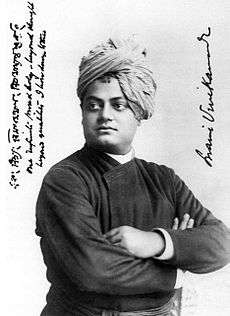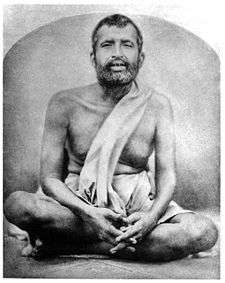Ramakrishna Mission Vidyapith, Deoghar
| Ramakrishna Mission Vidyapith | |
|---|---|
| Location | |
 Ramakrishna Mission Vidyapith  Ramakrishna Mission Vidyapith | |
|
Deoghar, Jharkhand, India 814112 | |
| Coordinates | 24°30′20″N 86°41′46″E / 24.50556°N 86.69611°ECoordinates: 24°30′20″N 86°41′46″E / 24.50556°N 86.69611°E |
| Information | |
| School type | Residential Boys' Senior Secondary |
| Established | 1922 |
| Medium of language | English |
| Publication | Sangeet Sangraha, Sangeet Mala, Vivekananda Katha O Galpa, Vivekananda ki Laghu Kathayaein, Atma Vikas, Baccho ke Sri Ramakrishna in Hindi |
| Affiliation | Central Board of Secondary Education(CBSE) |
| Website | http://www.rkmvdeoghar.org/ |
Ramakrishna Mission Vidyapith, Deoghar is a residential boys' senior secondary school in Deoghar, Jharkhand, India, established in 1922. It is the oldest institute of Ramakrishna Mission, and used to be visited by brother disciples of Swami Vivekananda. Swami Atmaprabhananda served as a principal during the 1990s.
It is exclusively for boys and permanently affiliated to the Central Board of Secondary Education. Admission to its Secondary section is restricted to standard VI only. However, a few students from other schools are also admitted in class XI, in case the seats are available for them after giving entry to its own students who do well in class X Board examination. The school offers education in science stream only in its Senior Secondary Section. The boys are taken in it entirely on merit ascertained by dint of written, oral and other tests. Ramakrishna Mission Vidyapith, Deoghar was ranked 4000 out of all CBSE schools in 2015 basis overall aggregates in Class XII CBSE exams in 2015.[1]
The Holy Trio
Sri Ramakrishna
Sri Ramakrishna was born Gadadhar Chatterjee in 1836 at Kamarpukur about sixty miles from Calcutta. His parents, Khudiram and Chandramani, were poor and made ends meet with great difficulty. He disliked going to school and, when asked why he did not want to go to school, his reply was The so-called education is for earning money only ; I don't care for this kind of education.
He loved Nature and spent his time in fields and fruit gardens outside the village with his friends. Gadadhar lost his father at the age of seven. He became more serious from then on, but he did not change his ways and habits. For instance, he would not go to school, Instead, he was seen visiting monks who stopped at his village on their way to Puri. He would serve them and listen with attention to the arguments they had among themselves over religious issues.
Gadadhar had now attained the age when he should be invested with the sacred thread. When arrangements were nearly complete for this, Gadadhar declared that he would have his first alms as a brahmin from a certain sudra woman of the village.
When Gadadhar started worshipping the deity, he began to ask himself if he was worshipping a piece of stone or a living Goddess. If he was worshipping a living Goddess, why should she not respond to his worship? This question nagged him day and night. Then, he began to pray to Kali - "Mother, you've been gracious to many devotees in the past and have revealed yourself to them. Why would you not reveal yourself to me, also? Am I not also your son?"
He would weep bitterly and sometimes even cry out loudly while worshipping. At night, he would go into a nearby jungle and spend the whole night praying. One day he was so impatient to see Mother Kali that he decided to end his life. He seized a sword hanging on the wall and was about to strike himself with it when he saw light issuing from the deity in waves and he was soon overwhelmed by those waves. He then fell down unconscious on the floor.
Soon word spread about this remarkable man and people of all denominations and all stations of life began to come to him. From now on he came to be known as Ramakrishna Paramahansa, and like a magnet he began to attract real seekers of God. He died in 1886, leaving behind a devoted band of young disciples headed by the scholar and orator, Swami Vivekananda.
Sri Sarada Devi
Endearingly known as ‘Holy Mother’, Sri Sarada Devi, the spiritual consort of Sri Ramakrishna, was born on 22 December 1853 in a poor Brahmin family in Jayrambati, a village adjoining Kamarpukur in West Bengal. Her father was Ramachandra Mukhopadhyay and her mother was Shyama Sundari Devin.
As a child Sarada was devoted to God. She had no formal schooling, but learnt the Bengali alphabet. When she was about six years old, she was married to Sri Ramakrishna, according to the custom prevalent in India in those days.
Sri Ramakrishna looked upon Sarada Devi as a manifestation of the Divine Mother of the universe. Under the strain of constant physical work and self-denial and repeated attacks of malaria, her health deteriorated in the closing years of her life, and she died on 21 July 1920.
Swami Vivekananda
Swami Vivekananda, known in his pre-monastic life as Narendra Nath Datta, was born in an affluent family in Kolkata on 12 January 1863. His father, Vishwanath Datta, was an attorney, his mother was Bhuvaneshwari Devi. Narendra excelled in music, gymnastics and studies. By the time he graduated from Calcutta University, he had acquired a particular knowledge of Western philosophy and history. Born with a yogic temperament, he practised meditation even from his boyhood, and was associated with Brahmo Movement for some time.
Emblem
The emblem of the Ramakrishna Order was designed by Swamiji. The meaning behind the emblem, in the language of Vivekananda himself: "The wavy waters in the picture are symbolic of Karma, the lotus of Bhakti, and the rising-sun of Jnana. The encircling serpent is indicative of Yoga and awakened Kunadalini Shakti, while the swan in the picture stands for Paramatman. Therefore, the ideal of the picture is that by the union of Karma, Jnana, Bhakti and Yoga, the vision of the Paramatman is obtained"
About the school
Administration
The institute is run by monks (sanyasins) & Brahmacharins of the Ramakrishna Order. The staff includes teachers from all over India as well as from foreign countries. The current secretary is Swami Tyagarupananda (as in sept 2016).
Campus
The school campus contains many attractive buildings. The most beautiful of the Vidyapith campus is the Universal Temple. It depicts the original temple of Belur Math. Under the temple, there is the school library with more than 26,000 books. There is a hospital inside the complex which deals with the minor injuries and problems of the students.
The dining hall is where guests and visitors come to have their meals. It serves food including vegetarian to non-vegetarian dishes. For the weak children, for their religious, cultural, and other extracurricular activities, they have been provided with an independent premise having the needed buildings, open space and equipment.
Dormitories
There are 11 dhams (dormitory) in the Secondary Section, namely, Yogananda Dham, Ramakrishnananda Dham, Adbhutananda Dham, Brahmananda Dham, Vivekananda Dham, Akhandananda Dham, Premananda Dham, Vijnananda Dham, Matri Dham, Saradananda Dham, Subodhananda Dham.
There are 4 dhams (dormitory) in the Senior Secondary Section.
Vivekananda Taran-tal and auditorium
The school has a standard size swimming pool named "Vivekananda Taran-tal", inaugurated on 22 January 2009.
The school have a theater sized auditorium, with an audience capacity of around 600. Every year functions such as Inter-School competitions, debates, seminars, and prize distribution are performed there. Other schools in the city come to the school to hold their functions.
Dairy
Vidyapith has a dairy to cater to the need of milk of its Ashramites.
Other attractions
Vidyapith has a small aviary-cum-greenhouse and a small medicinal orchard.
Vidyapith has established a museum which shows the ancient and tribal heritage of the country. It contains a wing on the life of Holy Mother Sri Sarada Devi, spiritual consort of Sri Ramakrishna. This wing is known as Sarada Darshan.
Ramakrishna Darshan and Literature Corner
There is a permanent exhibition Ramakrishna Darshan on the lives and contributions of Sri Ramakrishna and his disciples, emphasizing the service for mankind by Swami Vivekananda. This educates its visitors through photographs, glass fiber models and a history of the Ramakrishna Movement.
Vidyapith has a Religious Literature Corner where publications on Sri Ramakrishna, Sri Sarada Devi, Swami Vivekananda, the Vedanta and the Indian culture are kept for sale..
The Universal Temple
The Universal Temple of Sri Ramakrishna held in the bosom of the Vidyapith campus is a place of attraction to the religious minded. There, morning prayer and evening services (Aratrik) are conducted by the resident boys as part of their daily routine. Religious festivals, observances and worships are carried out in it.
Location
Ramakrishna Mission Vidyapith is located in the heart of Devghar( Deoghar), Jharkhand. Deoghar, being the holy abode of Lord Shiva, it is one of the most significant places of pilgrimage in the country. It is an ancient city, which harbours in its bosom a body part of Sati the Divine Mother.
The school is 20 minutes drive from the Jasidih railway junction.
References
- ↑ "15 out of 20 top CBSE schools are in South - Times of India". Retrieved 2016-07-28.
- Bhattacharyya, Somnath. "Kali's Child: Psychological And Hermeneutical Problems". Infinity Foundation. Archived from the original on 2007-10-04. Retrieved 2008-03-15.
- Gupta, Mahendranath ("M."); Swami Nikhilananda (1942). The Gospel of Sri Ramakrishna. Ramakrishna-Vivekananda Center. ISBN 0-911206-01-9. Cite uses deprecated parameter
|coauthors=(help) - Heehs, Peter (2002). "Ramakrishna Paramahamsa". Indian Religions. Orient Blackswan.
- Saradananda, Swami; Swami Chetanananda (2003). Sri Ramakrishna and His Divine Play. St. Louis: Vedanta Society. ISBN 978-0-916356-81-1. Cite uses deprecated parameter
|coauthors=(help) - Spivak, Gayatri Chakravorty (28 December 2007). "Other Asias". Wiley-Blackwell.
- Tyagananda; Vrajaprana (2010). Interpreting Ramakrishna: Kali's Child Revisited. Delhi: Motilal Banarsidass. p. 410. ISBN 978-81-208-3499-6.
- Sen, Amiya P. (2001). "Three essays on Sri Ramakrishna and his times". Indian Institute of Advanced Study.
- Babaji Bob Kindler (2000). Sri Sarada Vijnanagita: Her Teachings, Selected and Arranged in Verse Form. SRV Associations. ISBN 978-1-891893-06-3. External link in
|publisher=(help) - Swami Gambhirananda (1955). Holy Mother Shri Sarada Devi.
- Swami Nikhilananda (1984). Gospel of the Holy Mother Sri Sarada Devi. Sri Ramakrishna Math Printing Press. ISBN 978-81-7120-400-7.
- Swami Saradeshananda. The Holy Mother as I Saw Her.
- Swami Tapasyananda. Sri Sarada Devi ; The Holy Mother. Sri Ramakrishna Math. ISBN 978-81-7120-487-8.
External links
- Official website
- An introduction to Maa Sarda
- Official website of the Headquarters of Ramakrishna Math and Ramakrishna Mission
- Website for Ramakrishna Mission alumni


